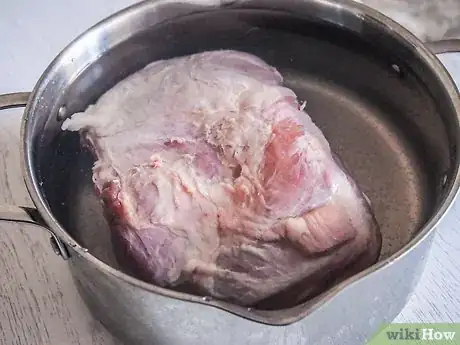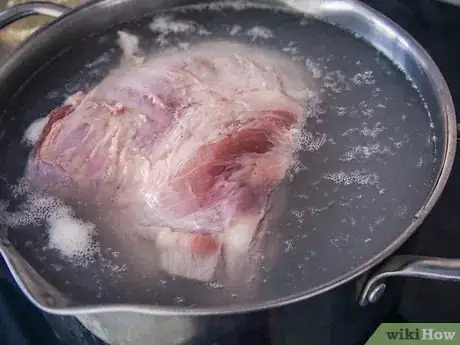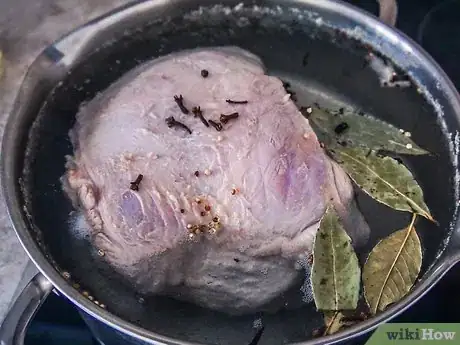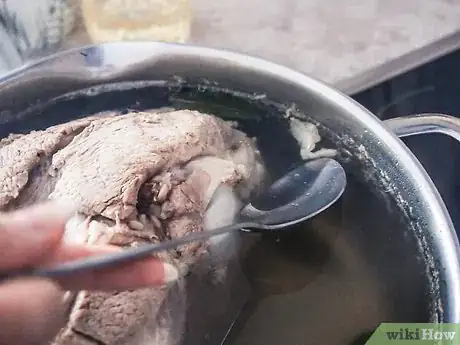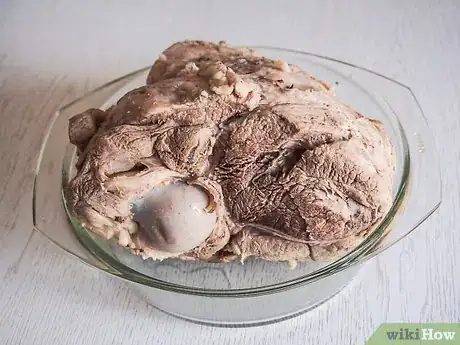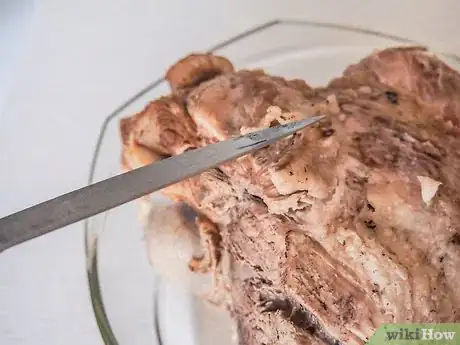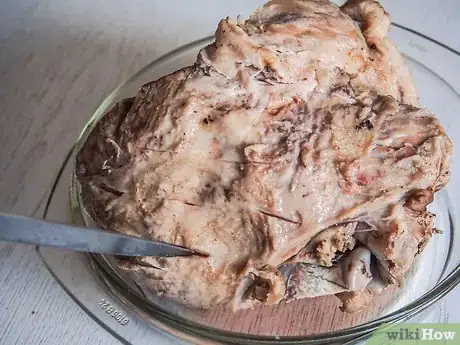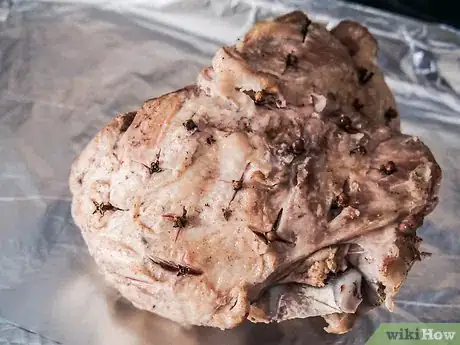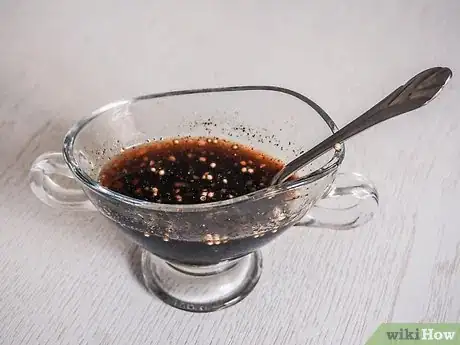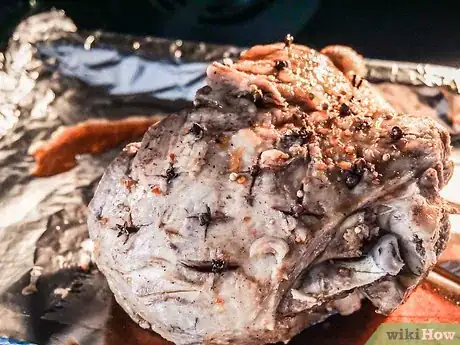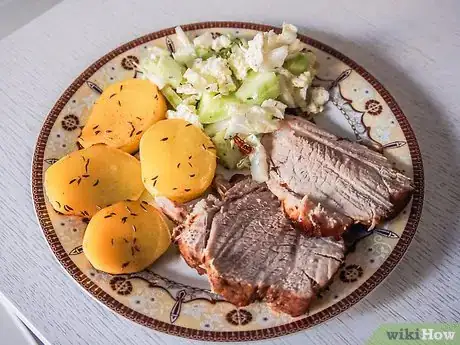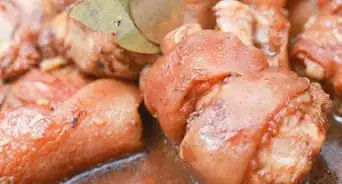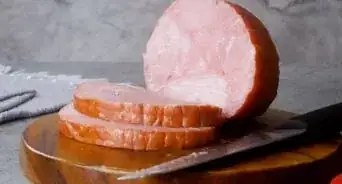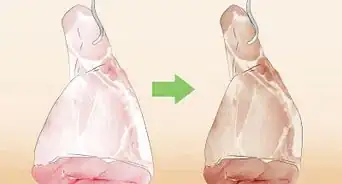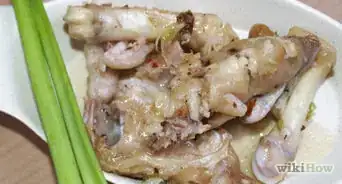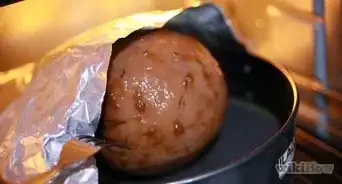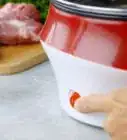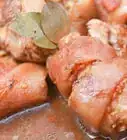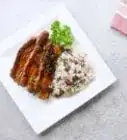This article was co-authored by wikiHow Staff. Our trained team of editors and researchers validate articles for accuracy and comprehensiveness. wikiHow's Content Management Team carefully monitors the work from our editorial staff to ensure that each article is backed by trusted research and meets our high quality standards.
There are 13 references cited in this article, which can be found at the bottom of the page.
This article has been viewed 34,483 times.
Learn more...
A holiday ham is a tradition for a good reason--it's delicious! Gammon is just uncooked ham, so you need to boil it before it goes in the oven. You can add spices and vegetables to the water to create a more flavorful ham. Then, get it ready for the oven by removing the skin and scoring the fat. Before sticking it in the oven, add a flavorful glaze to create a tasty, sweet layer on the outside of the ham.
Steps
Boiling Your Gammon Joint
-
1Place your gammon joint in a large pot with water. Pick a pot that's large enough to hold your joint. Pour in cold water, making sure to submerge the joint. Cover the pot with a lid.[1]
- If your pot isn't big enough, make sure to turn the joint over halfway through cooking it.
-
2Bring the pot to a boil and then drain the water. Place the pot on a burner turned to high heat. Let the water come up to a rolling boil. When it does, pour off the water in the sink.[2]
- This step helps get rid of the foam that builds up when the meat is cooking. However, you can also just skim the foam off periodically.[3]
Advertisement -
3Fill the pot back up with water and add seasonings. Cover the joint again with cold water, and put seasonings in the pot. You can add seasonings like peppercorns and bay leaves, as well as vegetables like carrots, celery, or onions.[4]
- You can just add a pinch of each seasoning, such as 12 peppercorns and 4 bay leaves.
- You can also use cinnamon, cloves, oranges, or coriander. Use small dashes of cinnamon and clove, as they can overpower the ham flavor.
-
4Simmer the joint for 30 minutes per 1 pound (0.45 kg) of meat. Let the pot come to a boil again over high heat, and then turn it down so the pot simmers. Use a spoon to skim any foam from the top. Discard the foam.[5]
-
5Drain the joint. Once the joint is done, let it sit for about 15 minutes outside the water, which will allow it to cool down. You can reserve the liquid to make soup later, or simply drain it off.[6]
Preparing the Joint for the Oven
-
1Remove the layer of skin. With a sharp knife, slice off the top layer of skin, leaving the fat underneath it intact. The fat adds flavor and crisps up in the oven. Plus, it helps protect the meat from drying out.[7]
-
2Score the fat with a knife. Scoring the fat just means making cuts across it. Typically, you make slices across it one way with each line about 1⁄2 to 3⁄4 inch (1.3 to 1.9 cm) apart. Then, make slices going the opposite direction, too.[8]
- Essentially, you're making a diamond pattern across the meat.
- Scoring the fat helps it render, meaning melt down. That will make the outside crispy.[9]
-
3Add whole cloves to each "X" if desired. Whole cloves are a traditional addition to a gammon or ham joint. Push in a whole clove where each scoring mark makes an "X" on the ham, making it look studded.[10]
- Cloves have a point on one side that will allow you to just push it into the ham. If you have trouble, make a small cut with a knife into the center of the "X," and slip the clove in.
Roasting the Joint
-
1Set the ham in a roasting pan. The "gammon" is officially ham now since it's been cooked. Set it in a roasting pan large enough to hold it, preferably one with a lid.[11]
- Line the pan with foil first for easy cleanup.
-
2Make your glaze. A glaze is just a sweet, thick sauce that you coat the ham with. Glazes can contain anything from honey and mustard to maple syrup or marmalade. It's all in the flavors you want to create. A glaze is not absolutely necessary; it just adds another layer of flavor.
- Try equal parts of honey and mustard or equal parts maple syrup and mustard. Dijon or coarse-grain mustards are good options.[12]
- Alternatively, try a marmalade glaze with 3 spoonfuls of bitter orange marmalade, the juice of 1 orange, and 5 fluid ounces (150 mL) of rum.
- For a spiced marinade, add about 2 teaspoons (5 g) of ground allspice, nutmeg, ginger, cinnamon, and cloves to a bowl. Mix in 2 tablespoons (30 mL) of honey and 3.5 fluid ounces (100 mL) of rum. Mix it together well before using it as a glaze.[13]
-
3Glaze the meat by spooning it over the ham. Spoon enough glaze over the ham to coat the meat thoroughly. Use the spoon to spread it out evenly over the meat, so the flavor reaches the whole thing. If you need to, use a kitchen brush to help spread the glaze out.[14]
-
4Cook the meat at 425 °F (218 °C) for 20-30 minutes. Place the ham in a preheated oven.[15] Let it cook for about 10-15 minutes, then take it out. Pour the rest of the glaze over the ham, and turn the pan around before sticking it back in the oven for another 10-15 minutes.[16]
- Turning the pan around allows the meat to cook more evenly.
-
5
-
6Take the ham out of the oven and let it rest for 15 minutes. Once the ham is done, give it a chance to rest. You should leave it alone for about 15 minutes. If you cut it too soon, it will release more juice than you want.[19]
- You can carve the ham while it's hot or cold. Ham can also be served hot or cold, depending on your preference.
- Store ham in an airtight container for 3 to 5 days in the refrigerator or up to 2 months in the freezer.[20]
Community Q&A
-
QuestionHow do you know if Gammon is cooked in the oven?
 Drew Hawkins1Community AnswerA Gammon cooked at 425 °F (218 °C) will take about 20-30 minutes to fully cook. You can tell that the ham is done when the fat on the outside turns crispy and golden brown. If the center of the ham is undercooked, but the fat is crispy, place some foil on top of the ham to protect it from the heat while the center finishes. It's also important that you let the ham rest for 15 minutes when you remove it from the oven.
Drew Hawkins1Community AnswerA Gammon cooked at 425 °F (218 °C) will take about 20-30 minutes to fully cook. You can tell that the ham is done when the fat on the outside turns crispy and golden brown. If the center of the ham is undercooked, but the fat is crispy, place some foil on top of the ham to protect it from the heat while the center finishes. It's also important that you let the ham rest for 15 minutes when you remove it from the oven. -
QuestionDo you have to boil a gammon joint before roasting?
 Drew Hawkins1Community AnswerYes, a gammon is uncooked ham and needs to be boiled before it goes into the oven. Place the gammon in a large pot with water, bring the pot to a boil, then drain the water to help get rid of the foam that builds up. Refill the pot with water and add all of your seasonings. Let the pot come to a boil again and turn down the heat to let the gammon simmer for 30 minutes per 1 pound (0.45 kg) of meat. You can then roast it in the oven.
Drew Hawkins1Community AnswerYes, a gammon is uncooked ham and needs to be boiled before it goes into the oven. Place the gammon in a large pot with water, bring the pot to a boil, then drain the water to help get rid of the foam that builds up. Refill the pot with water and add all of your seasonings. Let the pot come to a boil again and turn down the heat to let the gammon simmer for 30 minutes per 1 pound (0.45 kg) of meat. You can then roast it in the oven. -
QuestionIs Gammon better than ham?
 Drew Hawkins1Community AnswerGammon is the meat of the hind legs of a pig that has been cured and is sold raw. In order to be eaten, gammon has to be cooked and turned into ham. Boil the gammon first, then roast it in the oven. Because you're cooking the gammon yourself, it will likely have fewer preservatives and salt, which means it can be healthier than store-bought ham.
Drew Hawkins1Community AnswerGammon is the meat of the hind legs of a pig that has been cured and is sold raw. In order to be eaten, gammon has to be cooked and turned into ham. Boil the gammon first, then roast it in the oven. Because you're cooking the gammon yourself, it will likely have fewer preservatives and salt, which means it can be healthier than store-bought ham.
Things You'll Need
- Large pot
- Slotted spoon
- Seasonings, optional
- Small knife
- Roasting pan
- Glaze, optional
- Foil, optional
- Carving knife
References
- ↑ https://www.bbc.com/food/recipes/traditional_honey-glazed_52289
- ↑ https://www.bbc.com/food/recipes/traditional_honey-glazed_52289
- ↑ https://www.bbcgoodfood.com/howto/guide/how-cook-and-prepare-gammon-and-ham
- ↑ https://www.bbc.com/food/recipes/traditional_honey-glazed_52289
- ↑ https://www.bbcgoodfood.com/howto/guide/how-cook-and-prepare-gammon-and-ham
- ↑ https://www.bbc.com/food/recipes/traditional_honey-glazed_52289
- ↑ https://www.bbcgoodfood.com/howto/guide/how-cook-and-prepare-gammon-and-ham
- ↑ https://www.bbcgoodfood.com/howto/guide/how-cook-and-prepare-gammon-and-ham
- ↑ https://www.greatbritishchefs.com/how-to-cook/how-to-roast-gammon
- ↑ https://www.bbc.com/food/recipes/traditional_honey-glazed_52289
- ↑ https://www.bbc.com/food/recipes/traditional_honey-glazed_52289
- ↑ https://www.bbcgoodfood.com/howto/guide/how-cook-and-prepare-gammon-and-ham
- ↑ https://www.jamieoliver.com/news-and-features/features/how-to-make-roast-ham/
- ↑ https://www.greatbritishchefs.com/how-to-cook/how-to-roast-gammon
- ↑ https://www.bbcgoodfood.com/howto/guide/how-cook-and-prepare-gammon-and-ham
- ↑ https://www.bbc.com/food/recipes/traditional_honey-glazed_52289
- ↑ http://www.maryberry.co.uk/recipes/main-courses/gammon-with-a-ginger-glaze
- ↑ https://www.bbc.com/food/recipes/traditional_honey-glazed_52289
- ↑ https://www.bbc.com/food/recipes/traditional_honey-glazed_52289
- ↑ https://www.foodsafety.gov/keep/charts/hamstoragechart.html
About This Article
To cook a gammon joint in the oven, start by simmering the joint in boiling water for 30 minutes for each pound of meat. Doing this will reduce the amount of foam when the joint is cooking. After your joint is ready, remove the layer of skin, but leave the fat intact. Make criss-crossing cuts into the fat and add whole cloves to each cut. Then, place the ham in a foil-lined baking tray and cover the meat with your chosen glaze, such as honey and mustard. Finally, cook your meat at 425 degrees Fahrenheit for 20 to 30 minutes. You'll know the gammon is ready when the fat turns crispy and golden. For tips on how to store or serve your ham, read on!
